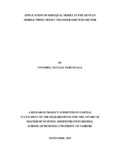Application of servqual model in the Kenyan mobile phone money transfer services sector
| dc.contributor.author | Onyimbo, Neville N O | |
| dc.date.accessioned | 2016-04-21T07:22:32Z | |
| dc.date.available | 2016-04-21T07:22:32Z | |
| dc.date.issued | 2015 | |
| dc.identifier.uri | http://hdl.handle.net/11295/94486 | |
| dc.description.abstract | Service quality measurement is a recurring problem in literature. The elements of service quality and ways of measuring them are still contentious. The purpose of this study was to find out how applicable SERVQUAL model is in the context of the mobile phone money transfer service sector in Kenya. The objectives entailed determination of the gap between expected and perceived service quality apart from establishing the relationship between the five SERVQUAL dimensions to the overall service quality in the Kenyan mobile phone money transfer service sector. Data was collected through cross-sectional survey by snowballing targeting a sample of 120 respondents proportional to the KNBS wage population by sectors within Mvita Sub-County of Mombasa County. A self-administered questionnaire was used with adapted SERVQUAL items to the context of study based on the five-point Likert scale. The SPSS software was used to determine the gap between expected and perceived service quality by the paired t-test after which regression analysis established the relationship between the SERVQUAL dimensions to overall service quality in order to identify the dominant dimensions. The findings established that there is a gap between the expectations and perceptions of consumers which needs to be filled by mobile phone money service providers. From the study, it was found that overall service quality was perceived low (-.37531) meaning expectations exceeded perceptions on services. The only expectation fully satisfied was provision of error free transactions. The practical implication of this study is that the sector regulator needs to upgrade the QoS measurement model to incorporate the consumer component and also integrate quality measurement across the suite of services offered. It was realized that identification of dominant service quality dimensions in different service industries will assist in guiding operations managers to deploy specialized service design and delivery in an effort to enhance the quality of services that meet consumers’ expectations. | en_US |
| dc.language.iso | en | en_US |
| dc.publisher | University of Nairobi | en_US |
| dc.title | Application of servqual model in the Kenyan mobile phone money transfer services sector | en_US |
| dc.type | Thesis | en_US |

